The development of machine guns in 1914-1918's
With the help of machine guns, a sharp "rarefaction" in the combat formations of the infantry was compensated. In 1915, deep-echeloned waves replaced the rifle chains. Machine guns for the first wave to quickly take up positions (preferably - allowing flank fire), but too bulky machine guns could not keep up with the advanced units and could only help in the preparation of the attack. Despite this equipment of machine-gun subunits by goniometers-quadrants, stereodalnomery and binoculars helped develop methods of firing into the intervals between their units and through the head. During the war, the demand for light machine guns was growing, becoming one of the main infantry fire weapons. Light machine guns, yielding in heavy intensity, could follow small subunits everywhere and quickly take up a position. Cavalry also favored light machine guns, since they were easier and much faster loaded and removed from the packs.
Manual machine guns to the beginning of the war were worked out much less than machine guns, but the need for them was so critical that everything was used - the alteration of machine guns (for example, MG.08 / 15 and 08 / 18 in Germany), the creation of quite successful new systems ( “Lewis” in the USA) or hastily made improvisations (“Shosh” machine gun in France). In 1916, there was a sharp increase in the number of light machine guns in the armies of France, Britain and Germany. For example, already at the beginning of 1916, in each infantry brigade of the British Army there was a company of Vickers machine guns, and in the battalion there was a branch of Lewis machine guns. By 1917, France significantly increased the production of light machine guns, ceasing the production of heavy machine guns.
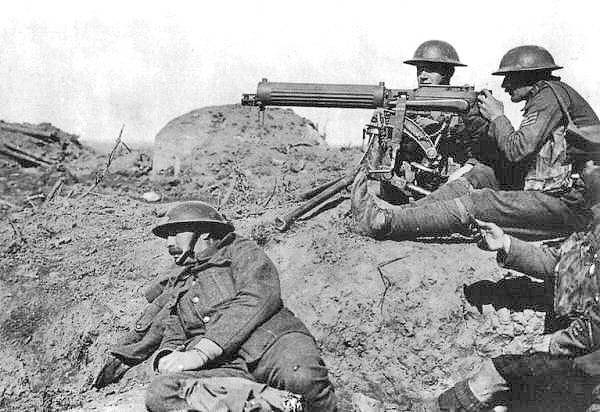
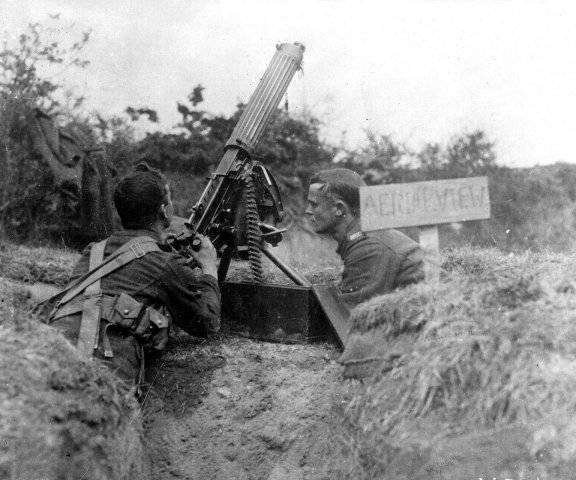
In 1917-1918, group tactics are being formed in defense and attack — small infantry groups assembled around light machine guns become the basis of battle formation. A.A. Neznamov wrote: “The chain inside the position was completely unsuitable; the main role here was played by “groups” having machine guns or machine guns alone ... A light machine gun provided the group with greater independence and combat value. ” In the German Reichswehr assault detachments and groups were created that were in dire need of light automatic weapons. On sections of the main attack, infantry units reinforced subunits of light machine guns. In addition, light machine guns, which moved quickly and hid easily, reinforced security, defense of advanced trenches, as well as counter-attack groups. Also important was the fact that the production of light machine guns was much cheaper than heavy machine guns, which affected the growth rate of their production. Manual machine guns take the place of company and platoon firing means. In 1917, the German Reichswehr on the Western Front had about 16 thousand machine guns and 3 thousand machine guns, but by the year 1918 their number was 28 thousand and 56 thousand, respectively (1: 2 ratio). In 1917, the French army had about 13 thousand machine guns and 91 thousand light machine guns (1: 7 ratio; the French after the war attempted to turn almost all infantry into light and machine guns).
Attempts to create "universal" machine guns are interesting: in Germany - on the basis of machine guns MG.08 and MG.15nА, in the UK - on the basis of the Lewis light machine gun. Great Britain, France and Germany had much more opportunities to produce light automatic weapons - and, therefore, for the development of group tactics - than Russia. Despite this, the Russian command also determined a high proportion of gun-guns.
At an inter-allied conference in January 1917, Russia stated that the company needs 8 machine guns per company, that is, 128 units per infantry regiment and 36 units per cavalry regiment, plus machine guns were required for aviation. However, these plans were not implemented.
Calculations for more active use of machine guns supplied portable shields (instead of shields on the machines) and "shells". "Armor" and "cuirass" actively used the offices of light machine guns of assault groups of the German army.
However, the light machine guns used at the time were heavy. This was the reason for the emergence of a number of "intermediate" types of weapons that previously simply would not have the right to exist. As light machine guns appeared between the heavy machine gun and the failed automatic rifle, so between a light machine gun, a pistol and an automatic rifle, a machine gun and a submachine gun appeared, which later became the category of individual weapons. The Italian double-barreled Villar-Pyroza of the A. Revelli model 1915 of the year, with armor and bipod, was designed for defense of trenches from short distances. Due to the simplicity of its production, the not very successful Revelly system was able to replace part of the Vickers and Maximovs in the Italian trenches. A more successful type of MP.18 “Bergman” machine gun (Germany), created by Schmeisser according to the “karabinerna” scheme, determined the further development of submachine guns for many years.
In Russia, the problem of light group automatic weapons was decided by VG Fedorov. Colonel Fedorov in January 1916, the state of automatic weapons in the Allied armies was as follows: “They order rifles, machine guns and not automatic rifles. Currently, machine guns are certainly more important than rifles. I suppose for our army the only question is the need for a wide testing of various systems of automatic rifles and rifles-machine guns in combat conditions. At the same time, it is necessary to order from 3 to 5 thousands of automatic rifles with a magazine for 20-25 ammunition and capable of continuous fire. Due to the substantial reworking of his own prototype automatic rifle of the 1913 model, Fedorov created a “hand-held machine gun” (which was later called an “automatic”). In the new design, he introduced such innovations as a translator of fire modes, shortening of the barrel, a removable magazine and a front hold handle. This first "assault" automatic weapons were intended to become a means of supporting small units (up to half of the squad). 6,5-millimeter "handgun-machine gun" successfully tested in the squadrons. In the fall of 1916, eight 7,62-mm machine guns with automatic rifles were betrayed by a specially formed separate company of the 189-i Izmail Infantry Regiment. This company was supposed to test group tactics (the calculations of the “guns-machine guns” were supplied, for example, with portable armored vehicles and optical sights), however, having entered the Romanian front, they did not have time to show themselves. To put on the production of 6,5-millimeter "handgun, machine gun" to 1918 year could not.
Of the foreign models developed at that time, close to this solution was the “Browning automatic rifle”, the magazine of which was designed for 20 cartridges, and adopted in the United States as a light machine gun. Manual light machine gun Farkauer Hill (England) remained only as a prototype. In Germany, the experienced Mauser automatic rifle in the 1910-1913 was supplemented with a translator of fire as well as an 25-cartridge magazine. However, this rifle was adopted only in aviation. It was only at the end of the 20s - the beginning of the 30s that a satisfactory system of the light machine gun was developed. At the same time, machine guns and submachine guns, which were created as a substitute for light machine guns, were transferred to the category of individual weapons. The appearance of tanks and combat aircraft caused the appearance of another type of machine gun - a large-caliber machine gun. In 1917, the French company “Hotchkiss” launched the 11-mm machine gun MIe 1917 “Ballun”. It was intended for firing on aerostats. MIe 1917 "Ballun" was developed under the old cartridge "gra" having a newly developed incendiary bullet. In 1918, the 13,32 mm TuF machine gun was created in Germany. However, these models were unsuccessful - primarily because of their bulkiness and installation parameters. In Russia, the issue of creating a large-caliber machine gun was not raised. At the same time, in the Russian army, as in the British and German armies, small-caliber automatic guns were used to destroy air and ground targets.
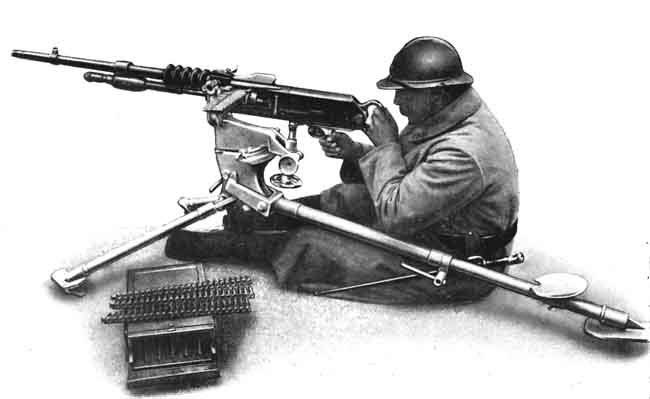
The First World War caused a sharp increase in the share of machine guns in the armaments of the troops. The infantry battalion of the French army in 1914 had 2 machine guns (light machine guns were absent), in 1916 year - 8 machine guns and 24 light machine guns, in 1918 year - 12 machine guns and 36 light machine guns. In Germany, an 1914 heavy machine gun was used for an infantry battalion in 2 (light machine guns were also absent), in 1916 - 8 heavy machine guns and 12 light machine guns, in 1918 - 12 machine guns and from 24 to 32 manual guns. The infantry battalion of the Russian army in 1914 had 2, in 1916, 8, in 1918, from 8 to 12 heavy machine guns. Manual machine guns were absent.
On average, the battalion firepower in the German and French armies increased 2,5 times, and the number decreased by 40-45%.
The change in the density of fire weapons per kilometer of the front and the relationship between artillery guns and machine guns can be seen in the following averaged figures:
Russian troops for 01.10.1914, machine guns - 2,6; tools - 5,2;
German-Austrian troops for 01.10.1914; machine guns - 1,8; tools - 2,3;
Russian troops for 01.10.1917, machine guns - 11,6; tools - 4,5.
In the Russian army in 1914 - 1917, the number of machine guns was increased 6 times (from 4152 to 23,8 thousand), in the German army during the same period - in 9 (from 12 thousand to 104 thousand), in the Austro-Hungarian - in 16 (from 2761 to 43,7 thousand), in French - in 20 (from 5 thousand to 100 thousand, the main increase fell on light machine guns).
Based on: S. Fedoseev - Machine Guns in the First World War
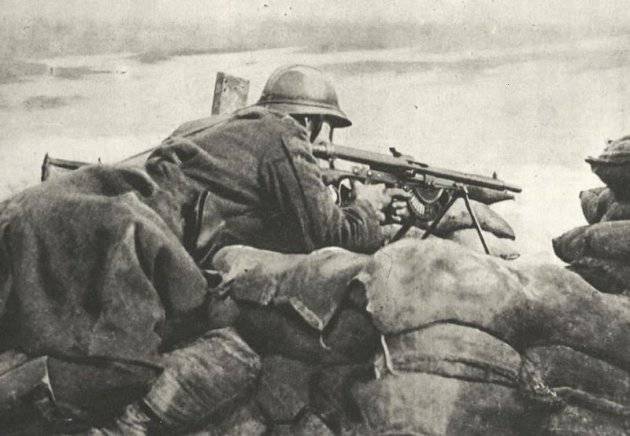
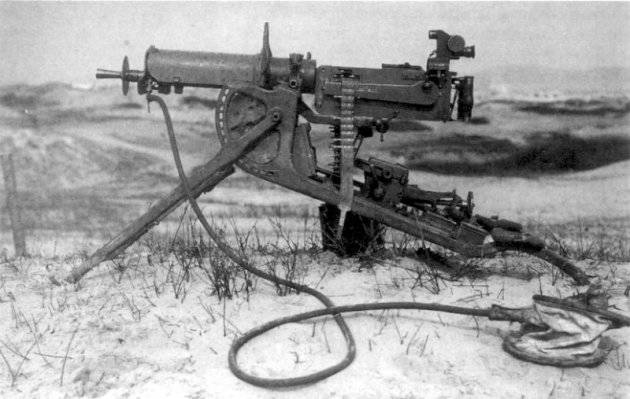
Information